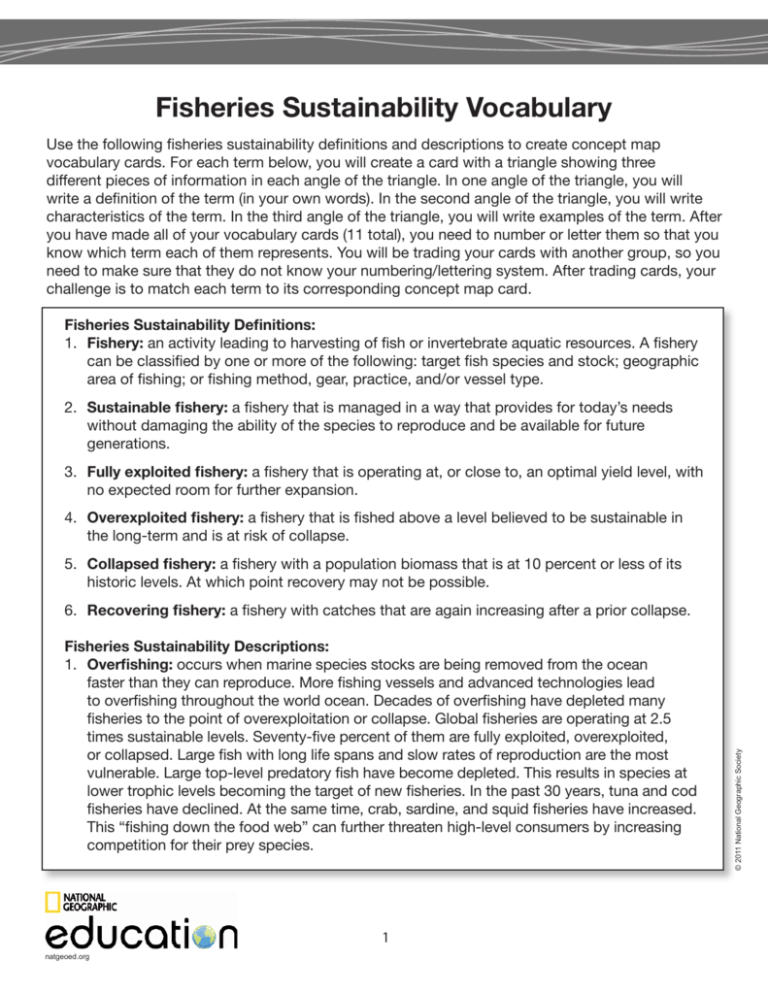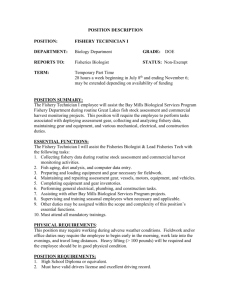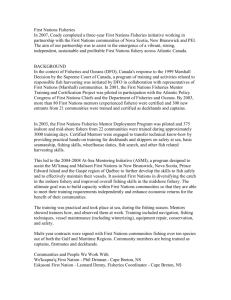Fisheries Sustainability Vocabulary
advertisement

Fisheries Sustainability Vocabulary Use the following fisheries sustainability definitions and descriptions to create concept map vocabulary cards. For each term below, you will create a card with a triangle showing three different pieces of information in each angle of the triangle. In one angle of the triangle, you will write a definition of the term (in your own words). In the second angle of the triangle, you will write characteristics of the term. In the third angle of the triangle, you will write examples of the term. After you have made all of your vocabulary cards (11 total), you need to number or letter them so that you know which term each of them represents. You will be trading your cards with another group, so you need to make sure that they do not know your numbering/lettering system. After trading cards, your challenge is to match each term to its corresponding concept map card. Fisheries Sustainability Definitions: 1. Fishery: an activity leading to harvesting of fish or invertebrate aquatic resources. A fishery can be classified by one or more of the following: target fish species and stock; geographic area of fishing; or fishing method, gear, practice, and/or vessel type. 2. Sustainable fishery: a fishery that is managed in a way that provides for today’s needs without damaging the ability of the species to reproduce and be available for future generations. 3. Fully exploited fishery: a fishery that is operating at, or close to, an optimal yield level, with no expected room for further expansion. 4. Overexploited fishery: a fishery that is fished above a level believed to be sustainable in the long-term and is at risk of collapse. 5. Collapsed fishery: a fishery with a population biomass that is at 10 percent or less of its historic levels. At which point recovery may not be possible. Fisheries Sustainability Descriptions: 1. Overfishing: occurs when marine species stocks are being removed from the ocean faster than they can reproduce. More fishing vessels and advanced technologies lead to overfishing throughout the world ocean. Decades of overfishing have depleted many fisheries to the point of overexploitation or collapse. Global fisheries are operating at 2.5 times sustainable levels. Seventy-five percent of them are fully exploited, overexploited, or collapsed. Large fish with long life spans and slow rates of reproduction are the most vulnerable. Large top-level predatory fish have become depleted. This results in species at lower trophic levels becoming the target of new fisheries. In the past 30 years, tuna and cod fisheries have declined. At the same time, crab, sardine, and squid fisheries have increased. This “fishing down the food web” can further threaten high-level consumers by increasing competition for their prey species. 1 natgeoed.org © 2011 National Geographic Society 6. Recovering fishery: a fishery with catches that are again increasing after a prior collapse. Fisheries Sustainability Vocabulary, continued 2. Illegal fishing: occurs when vessels conduct unreported or unregulated fishing. Illegal fishing accounts for one quarter of the world’s wild fish catch. It further contributes to overfishing when fisheries ignore and violate regulations. Regulations can be violated by the taking of undersized fish, using illegal gear, catching more than allowed by law, and fishing in closed areas or during closed seasons. Illegal fishing crimes and lack of enforcement also impact local economies. Such crimes can also threaten poor regions of the world that rely on their fisheries for food, security, and income. 3. Habitat damage: results from numerous human-related activities, including coastal development, pollution, and the use of destructive fishing gear. For example, dredges and trawl nets that drag along the seafloor to catch benthic (bottom-dwelling) fish often destroy everything in their path. Heavily trawled areas are like forests that have been clear-cut. Afterwards, their communities may never have the chance to recover. Alternatives for some fisheries include traps and pots that cause less habitat damage and decrease bycatch. 5. Fisheries management: refers to an integrated process of gathering and analyzing information, allocating resources, developing strategies, and formulating and enforcing regulations. Fisheries management ranges from strong and well-enforced to weak or nonexistent. Local or regional regulations meant to prevent overfishing, illegal fishing, habitat damage, and bycatch may only be effective on some levels. Species with wider ranges and migratory patterns (tuna, whales) may require different management strategies. Management strategies that have shown positive results include: regulations requiring catch limits, the use of better fishing gear, and the stoppage of illegal fishing. The development of Marine Protected Areas and an ecosystem approach to management have also been effective. 2 natgeoed.org © 2011 National Geographic Society 4. Bycatch: results when certain fishing nets and practices indiscriminately catch unwanted fish, sea birds, turtles, or marine mammals. These unwanted animals are caught while target species are fished. Worldwide, bycatch accounts for one out of every four fish caught and discarded. For example, for every pound of shrimp caught, bycatch levels are at least two pounds. Fishing gear that is less selective, including longlines and trawls, results in increased bycatch. Longline fishing is part of the reason that nearly 20 percent of shark species are threatened with extinction. Hook-and-line fishing limits bycatch because fishermen can quickly release unwanted catch species.










